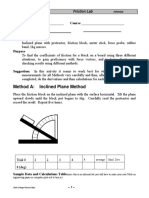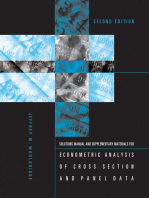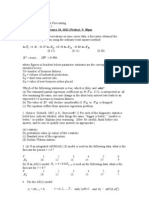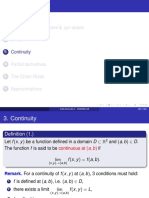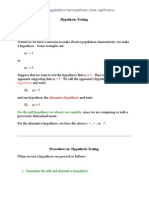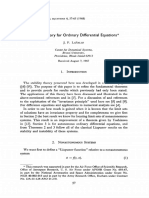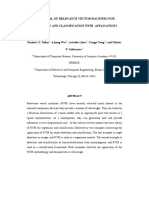5.2 Evaluation of Continued Fractions
5.2 Evaluation of Continued Fractions
Uploaded by
Vinay GuptaCopyright:
Available Formats
5.2 Evaluation of Continued Fractions
5.2 Evaluation of Continued Fractions
Uploaded by
Vinay GuptaOriginal Title
Copyright
Available Formats
Share this document
Did you find this document useful?
Is this content inappropriate?
Copyright:
Available Formats
5.2 Evaluation of Continued Fractions
5.2 Evaluation of Continued Fractions
Uploaded by
Vinay GuptaCopyright:
Available Formats
5.
2 Evaluation of Continued Fractions
169
into equation (5.1.11), and then setting z = 1. Sometimes you will want to compute a function from a series representation even when the computation is not efcient. For example, you may be using the values obtained to t the function to an approximating form that you will use subsequently (cf. 5.8). If you are summing very large numbers of slowly convergent terms, pay attention to roundoff errors! In oating-point representation it is more accurate to sum a list of numbers in the order starting with the smallest one, rather than starting with the largest one. It is even better to group terms pairwise, then in pairs of pairs, etc., so that all additions involve operands of comparable magnitude.
CITED REFERENCES AND FURTHER READING: Goodwin, E.T. (ed.) 1961, Modern Computing Methods, 2nd ed. (New York: Philosophical Library), Chapter 13 [van Wijngaardens transformations]. [1] Dahlquist, G., and Bjorck, A. 1974, Numerical Methods (Englewood Cliffs, NJ: Prentice-Hall), Chapter 3. Abramowitz, M., and Stegun, I.A. 1964, Handbook of Mathematical Functions, Applied Mathematics Series, Volume 55 (Washington: National Bureau of Standards; reprinted 1968 by Dover Publications, New York), 3.6. Mathews, J., and Walker, R.L. 1970, Mathematical Methods of Physics, 2nd ed. (Reading, MA: W.A. Benjamin/Addison-Wesley), 2.3. [2]
Sample page from NUMERICAL RECIPES IN C: THE ART OF SCIENTIFIC COMPUTING (ISBN 0-521-43108-5) Copyright (C) 1988-1992 by Cambridge University Press. Programs Copyright (C) 1988-1992 by Numerical Recipes Software. Permission is granted for internet users to make one paper copy for their own personal use. Further reproduction, or any copying of machinereadable files (including this one) to any server computer, is strictly prohibited. To order Numerical Recipes books or CDROMs, visit website http://www.nr.com or call 1-800-872-7423 (North America only), or send email to directcustserv@cambridge.org (outside North America).
5.2 Evaluation of Continued Fractions
Continued fractions are often powerful ways of evaluating functions that occur in scientic applications. A continued fraction looks like this: f (x) = b0 + a1 b1 +
a2 b2 +
b3 + a3 a4
(5.2.1)
a5 b4 + b5 +
Printers prefer to write this as f (x) = b0 + a2 a3 a4 a5 a1 b1 + b2 + b3 + b4 + b5 + (5.2.2)
In either (5.2.1) or (5.2.2), the as and bs can themselves be functions of x, usually linear or quadratic monomials at worst (i.e., constants times x or times x 2 ). For example, the continued fraction representation of the tangent function is tan x = x x2 x2 x2 1 3 5 7 (5.2.3)
Continued fractions frequently converge much more rapidly than power series expansions, and in a much larger domain in the complex plane (not necessarily including the domain of convergence of the series, however). Sometimes the continued fraction converges best where the series does worst, although this is not
170
Chapter 5.
Evaluation of Functions
a general rule. Blanch [1] gives a good review of the most useful convergence tests for continued fractions. There are standard techniques, including the important quotient-difference algorithm, for going back and forth between continued fraction approximations, power series approximations, and rational function approximations. Consult Acton [2] for an introduction to this subject, and Fike [3] for further details and references. How do you tell how far to go when evaluating a continued fraction? Unlike a series, you cant just evaluate equation (5.2.1) from left to right, stopping when the change is small. Written in the form of (5.2.1), the only way to evaluate the continued fraction is from right to left, rst (blindly!) guessing how far out to start. This is not the right way. The right way is to use a result that relates continued fractions to rational approximations, and that gives a means of evaluating (5.2.1) or (5.2.2) from left to right. Let fn denote the result of evaluating (5.2.2) with coefcients through an and bn . Then fn = An Bn (5.2.4)
Sample page from NUMERICAL RECIPES IN C: THE ART OF SCIENTIFIC COMPUTING (ISBN 0-521-43108-5) Copyright (C) 1988-1992 by Cambridge University Press. Programs Copyright (C) 1988-1992 by Numerical Recipes Software. Permission is granted for internet users to make one paper copy for their own personal use. Further reproduction, or any copying of machinereadable files (including this one) to any server computer, is strictly prohibited. To order Numerical Recipes books or CDROMs, visit website http://www.nr.com or call 1-800-872-7423 (North America only), or send email to directcustserv@cambridge.org (outside North America).
where An and Bn are given by the following recurrence: A1 1 A0 b0 Aj = bj Aj 1 + aj Aj 2 B 1 0 B0 1 j = 1, 2, . . . , n (5.2.5) This method was invented by J. Wallis in 1655 (!), and is discussed in his Arithmetica Innitorum [4]. You can easily prove it by induction. In practice, this algorithm has some unattractive features: The recurrence (5.2.5) frequently generates very large or very small values for the partial numerators and denominators A j and Bj . There is thus the danger of overow or underow of the oating-point representation. However, the recurrence (5.2.5) is linear in the As and B s. At any point you can rescale the currently saved two levels of the recurrence, e.g., divide A j , Bj , Aj 1 , and Bj 1 all by Bj . This incidentally makes A j = fj and is convenient for testing whether you have gone far enough: See if f j and fj 1 from the last iteration are as close as you would like them to be. (If B j happens to be zero, which can happen, just skip the renormalization for this cycle. A fancier level of optimization is to renormalize only when an overow is imminent, saving the unnecessary divides. All this complicates the program logic.) Two newer algorithms have been proposed for evaluating continued fractions. Steeds method does not use A j and Bj explicitly, but only the ratio D j = Bj 1 /Bj . One calculates Dj and fj = fj fj 1 recursively using Dj = 1/(bj + aj Dj 1 ) fj = (bj Dj 1)fj 1 (5.2.6) (5.2.7)
Bj = bj Bj 1 + aj Bj 2
Steeds method (see, e.g., [5]) avoids the need for rescaling of intermediate results. However, for certain continued fractions you can occasionally run into a situation
5.2 Evaluation of Continued Fractions
171
where the denominator in (5.2.6) approaches zero, so that D j and fj are very large. The next f j +1 will typically cancel this large change, but with loss of accuracy in the numerical running sum of the f j s. It is awkward to program around this, so Steeds method can be recommended only for cases where you know in advance that no denominator can vanish. We will use it for a special purpose in the routine bessik (6.7). The best general method for evaluating continued fractions seems to be the modied Lentzs method [6]. The need for rescaling intermediate results is avoided by using both the ratios Cj = Aj /Aj 1 , and calculating f j by fj = fj 1 Cj Dj Dj = 1/(bj + aj Dj 1 ), Cj = bj + aj /Cj 1 (5.2.9) (5.2.10) Dj = Bj 1 /Bj (5.2.8)
Sample page from NUMERICAL RECIPES IN C: THE ART OF SCIENTIFIC COMPUTING (ISBN 0-521-43108-5) Copyright (C) 1988-1992 by Cambridge University Press. Programs Copyright (C) 1988-1992 by Numerical Recipes Software. Permission is granted for internet users to make one paper copy for their own personal use. Further reproduction, or any copying of machinereadable files (including this one) to any server computer, is strictly prohibited. To order Numerical Recipes books or CDROMs, visit website http://www.nr.com or call 1-800-872-7423 (North America only), or send email to directcustserv@cambridge.org (outside North America).
From equation (5.2.5), one easily shows that the ratios satisfy the recurrence relations
In this algorithm there is the danger that the denominator in the expression for D j , or the quantity C j itself, might approach zero. Either of these conditions invalidates (5.2.10). However, Thompson and Barnett [5] show how to modify Lentzs algorithm to x this: Just shift the offending term by a small amount, e.g., 10 30 . If you work through a cycle of the algorithm with this prescription, you will see that f j +1 is accurately calculated. In detail, the modied Lentzs algorithm is this: Set f0 = b0 ; if b0 = 0 set f0 = tiny . Set C0 = f0 . Set D0 = 0. For j = 1, 2, . . . Set Dj = bj + aj Dj 1 . If Dj = 0, set Dj = tiny . Set Cj = bj + aj /Cj 1 . If Cj = 0 set Cj = tiny . Set Dj = 1/Dj . Set j = Cj Dj . Set fj = fj 1 j . If |j 1| < eps then exit. Here eps is your oating-point precision, say 10 7 or 1015 . The parameter tiny should be less than typical values of eps|b j |, say 1030 . The above algorithm assumes that you can terminate the evaluation of the continued fraction when |f j fj 1 | is sufciently small. This is usually the case, but by no means guaranteed. Jones [7] gives a list of theorems that can be used to justify this termination criterion for various kinds of continued fractions. There is at present no rigorous analysis of error propagation in Lentzs algorithm. However, empirical tests suggest that it is at least as good as other methods.
172
Chapter 5.
Evaluation of Functions
Manipulating Continued Fractions
Several important properties of continued fractions can be used to rewrite them in forms that can speed up numerical computation. An equivalence transformation an an , bn bn , an+1 an+1 (5.2.11)
Sample page from NUMERICAL RECIPES IN C: THE ART OF SCIENTIFIC COMPUTING (ISBN 0-521-43108-5) Copyright (C) 1988-1992 by Cambridge University Press. Programs Copyright (C) 1988-1992 by Numerical Recipes Software. Permission is granted for internet users to make one paper copy for their own personal use. Further reproduction, or any copying of machinereadable files (including this one) to any server computer, is strictly prohibited. To order Numerical Recipes books or CDROMs, visit website http://www.nr.com or call 1-800-872-7423 (North America only), or send email to directcustserv@cambridge.org (outside North America).
leaves the value of a continued fraction unchanged. By a suitable choice of the scale factor you can often simplify the form of the as and the bs. Of course, you can carry out successive equivalence transformations, possibly with different s, on successive terms of the continued fraction. The even and odd parts of a continued fraction are continued fractions whose successive convergents are f 2n and f2n+1 , respectively. Their main use is that they converge twice as fast as the original continued fraction, and so if their terms are not much more complicated than the terms in the original there can be a big savings in computation. The formula for the even part of (5.2.2) is feven = d0 + c2 c1 d1 + d2 + (5.2.12)
where in terms of intermediate variables 1 = n = we have d0 = b0 , a1 b1
an , bn bn1
n2
(5.2.13)
c1 = 1 ,
d1 = 1 + 2 n2
cn = 2n1 2n2 , dn = 1 + 2n1 + 2n ,
(5.2.14)
You can nd the similar formula for the odd part in the review by Blanch [1]. Often a combination of the transformations (5.2.14) and (5.2.11) is used to get the best form for numerical work. We will make frequent use of continued fractions in the next chapter.
CITED REFERENCES AND FURTHER READING: Abramowitz, M., and Stegun, I.A. 1964, Handbook of Mathematical Functions, Applied Mathematics Series, Volume 55 (Washington: National Bureau of Standards; reprinted 1968 by Dover Publications, New York), 3.10. Blanch, G. 1964, SIAM Review, vol. 6, pp. 383421. [1] Acton, F.S. 1970, Numerical Methods That Work; 1990, corrected edition (Washington: Mathematical Association of America), Chapter 11. [2] Cuyt, A., and Wuytack, L. 1987, Nonlinear Methods in Numerical Analysis (Amsterdam: NorthHolland), Chapter 1. Fike, C.T. 1968, Computer Evaluation of Mathematical Functions (Englewood Cliffs, NJ: PrenticeHall), 8.2, 10.4, and 10.5. [3] Wallis, J. 1695, in Opera Mathematica, vol. 1, p. 355, Oxoniae e Theatro Shedoniano. Reprinted by Georg Olms Verlag, Hildeshein, New York (1972). [4]
5.3 Polynomials and Rational Functions
173
Thompson, I.J., and Barnett, A.R. 1986, Journal of Computational Physics, vol. 64, pp. 490509. [5] Lentz, W.J. 1976, Applied Optics, vol. 15, pp. 668671. [6] Jones, W.B. 1973, in Pade Approximants and Their Applications, P.R. Graves-Morris, ed. (London: Academic Press), p. 125. [7]
Sample page from NUMERICAL RECIPES IN C: THE ART OF SCIENTIFIC COMPUTING (ISBN 0-521-43108-5) Copyright (C) 1988-1992 by Cambridge University Press. Programs Copyright (C) 1988-1992 by Numerical Recipes Software. Permission is granted for internet users to make one paper copy for their own personal use. Further reproduction, or any copying of machinereadable files (including this one) to any server computer, is strictly prohibited. To order Numerical Recipes books or CDROMs, visit website http://www.nr.com or call 1-800-872-7423 (North America only), or send email to directcustserv@cambridge.org (outside North America).
5.3 Polynomials and Rational Functions
A polynomial of degree N is represented numerically as a stored array of coefcients, c[j] with j= 0, . . . , N . We will always take c[0] to be the constant term in the polynomial, c[N ] the coefcient of x N ; but of course other conventions are possible. There are two kinds of manipulations that you can do with a polynomial: numerical manipulations (such as evaluation), where you are given the numerical value of its argument, or algebraic manipulations, where you want to transform the coefcient array in some way without choosing any particular argument. Lets start with the numerical. We assume that you know enough never to evaluate a polynomial this way:
p=c[0]+c[1]*x+c[2]*x*x+c[3]*x*x*x+c[4]*x*x*x*x;
or (even worse!),
p=c[0]+c[1]*x+c[2]*pow(x,2.0)+c[3]*pow(x,3.0)+c[4]*pow(x,4.0);
Come the (computer) revolution, all persons found guilty of such criminal behavior will be summarily executed, and their programs wont be! It is a matter of taste, however, whether to write
p=c[0]+x*(c[1]+x*(c[2]+x*(c[3]+x*c[4])));
or
p=(((c[4]*x+c[3])*x+c[2])*x+c[1])*x+c[0];
If the number of coefcients c[0..n] is large, one writes
p=c[n]; for(j=n-1;j>=0;j--) p=p*x+c[j];
or
p=c[j=n]; while (j>0) p=p*x+c[--j];
Another useful trick is for evaluating a polynomial P (x) and its derivative dP (x)/dx simultaneously:
p=c[n]; dp=0.0; for(j=n-1;j>=0;j--) {dp=dp*x+p; p=p*x+c[j];}
You might also like
- NG - Argument Reduction For Huge Arguments: Good To The Last BitDocument8 pagesNG - Argument Reduction For Huge Arguments: Good To The Last BitDerek O'ConnorNo ratings yet
- Weatherwax Weisberg SolutionsDocument162 pagesWeatherwax Weisberg SolutionsmathmagnetNo ratings yet
- Practical Examples Using EviewsDocument27 pagesPractical Examples Using EviewsNadeem Mumtaz GhumroNo ratings yet
- ML5Document5 pagesML5Anonymous C5ACgu0No ratings yet
- Bisection MethodDocument20 pagesBisection MethodAnonymous J8phVjlxPxNo ratings yet
- Mathematical Association of AmericaDocument17 pagesMathematical Association of AmericaAlim SultangazinNo ratings yet
- 5.14 Evaluation of Functions by Path Integration: M K 4 Rational Fit To The Function F (X) Cos X/ (1 + eDocument4 pages5.14 Evaluation of Functions by Path Integration: M K 4 Rational Fit To The Function F (X) Cos X/ (1 + eVinay GuptaNo ratings yet
- 2.5 Iterative Improvement of A Solution To Linear EquationsDocument5 pages2.5 Iterative Improvement of A Solution To Linear EquationsVinay GuptaNo ratings yet
- Panel Data Problem Set 2Document6 pagesPanel Data Problem Set 2Yadavalli ChandradeepNo ratings yet
- JCC 23935Document10 pagesJCC 23935amdavi9607No ratings yet
- Chap 2Document30 pagesChap 2Sharif M Mizanur RahmanNo ratings yet
- Single Response: Optimization When There Is Adequate Quadratic FitDocument7 pagesSingle Response: Optimization When There Is Adequate Quadratic FitLazaro CoutinhoNo ratings yet
- Bisection MethodDocument5 pagesBisection Methodanon_683251838100% (1)
- KIL1005: Numerical Methods For Engineering: Semester 2, Session 2019/2020 7 May 2020Document16 pagesKIL1005: Numerical Methods For Engineering: Semester 2, Session 2019/2020 7 May 2020Safayet AzizNo ratings yet
- CLP FD Constraint Logic Programming OverDocument12 pagesCLP FD Constraint Logic Programming OverViana Carlos VianaNo ratings yet
- Sample Sec 3Document16 pagesSample Sec 3meep1234No ratings yet
- S.no Topic Date SignatureDocument22 pagesS.no Topic Date SignatureAbhishek BhallaNo ratings yet
- C For MathematiciansDocument41 pagesC For MathematicianschinssuNo ratings yet
- CSC336 Midterm 1 Fall 2011Document3 pagesCSC336 Midterm 1 Fall 2011yellowmoogNo ratings yet
- 2015 Hw1011 KeyDocument5 pages2015 Hw1011 KeyPiNo ratings yet
- Homework 2 - Handwriting: Grading PolicyDocument3 pagesHomework 2 - Handwriting: Grading Policyvickychen910716No ratings yet
- Trapezoidal Rule 4Document35 pagesTrapezoidal Rule 4Grace LlobreraNo ratings yet
- Rational Functions: 5.4 Complex ArithmeticDocument3 pagesRational Functions: 5.4 Complex ArithmeticVinay GuptaNo ratings yet
- Friction LabDocument6 pagesFriction LabSarifudin HusniNo ratings yet
- Midterm SolutionsDocument14 pagesMidterm SolutionsEducation VietCoNo ratings yet
- 5.11 Economization of Power Series: D (0..n-1) (0..n-1) n-1 D n-1 A B DDocument3 pages5.11 Economization of Power Series: D (0..n-1) (0..n-1) n-1 D n-1 A B DVinay GuptaNo ratings yet
- Adams-Bashforth MethodsDocument5 pagesAdams-Bashforth Methodsbird05No ratings yet
- ArctanDocument9 pagesArctanPankaj GoyalNo ratings yet
- Implementation of A New Primality TestDocument23 pagesImplementation of A New Primality TestPOPNo ratings yet
- ACF and PACF in ExcelDocument11 pagesACF and PACF in ExcelErizelle Anne BrunoNo ratings yet
- 3.5 Coefficients of The Interpolating Polynomial: Interpolation and ExtrapolationDocument4 pages3.5 Coefficients of The Interpolating Polynomial: Interpolation and ExtrapolationVinay GuptaNo ratings yet
- CVFDdiffusion 2 DDocument17 pagesCVFDdiffusion 2 DMehdi AfzaliNo ratings yet
- CSC336 Assignment 1Document2 pagesCSC336 Assignment 1yellowmoogNo ratings yet
- Econometrics ExamDocument8 pagesEconometrics Examprnh88No ratings yet
- Adaptive Quadrature - RevisitedDocument18 pagesAdaptive Quadrature - RevisitedSaifuddin AriefNo ratings yet
- Parallel Iteration of The Extended Backward Differentiation FormulasDocument19 pagesParallel Iteration of The Extended Backward Differentiation FormulasTimothy DicksonNo ratings yet
- Diagnostico de ModelosDocument4 pagesDiagnostico de Modeloskhayman.gpNo ratings yet
- 10.3 One-Dimensional Search With First DerivativesDocument4 pages10.3 One-Dimensional Search With First DerivativesRajivSadewaNo ratings yet
- Unit 1 MT 202 CBNSTDocument24 pagesUnit 1 MT 202 CBNSTjssssssssssNo ratings yet
- Computational Finance Using MATLABDocument26 pagesComputational Finance Using MATLABpopoyboysNo ratings yet
- Brents MethodDocument12 pagesBrents MethodcharrasquidoNo ratings yet
- Advanced Algorithms Course. Lecture Notes. Part 8Document2 pagesAdvanced Algorithms Course. Lecture Notes. Part 8KasapaNo ratings yet
- CSE-1020 Midterm Exam: Written Portion Family Name: Given Name: Student#: CSE Account: Section: A EDocument12 pagesCSE-1020 Midterm Exam: Written Portion Family Name: Given Name: Student#: CSE Account: Section: A EexamkillerNo ratings yet
- CSE 331 Final Exam 3/18/13Document14 pagesCSE 331 Final Exam 3/18/13Aijin JiangNo ratings yet
- Homework Index: To See If The Questions Have Been Changed, or If You Are Required To Use Different Data or ExamplesDocument86 pagesHomework Index: To See If The Questions Have Been Changed, or If You Are Required To Use Different Data or ExamplesasNo ratings yet
- Highly Accurate Solutions of The Blasius and Falkner-Skan Boundary Layer Equations Via Convergence AccelerationDocument27 pagesHighly Accurate Solutions of The Blasius and Falkner-Skan Boundary Layer Equations Via Convergence AccelerationRaman BaluNo ratings yet
- Empirical Finance8Document11 pagesEmpirical Finance8edison6685No ratings yet
- COMPUTATIONAL FLUID DYNAMICS - Anderson, Dale A. Computational Fluid Mechanics and Heat Transfer100-150Document50 pagesCOMPUTATIONAL FLUID DYNAMICS - Anderson, Dale A. Computational Fluid Mechanics and Heat Transfer100-150mkashkooli_scribdNo ratings yet
- 4K410 - Exercises 2014-2015Document17 pages4K410 - Exercises 2014-2015Abhishek SharmaNo ratings yet
- Bayesian Analysis of Spatially Autocorrelated Data Spatial Data Analysis in Ecology and Agriculture Using RDocument18 pagesBayesian Analysis of Spatially Autocorrelated Data Spatial Data Analysis in Ecology and Agriculture Using Raletheia_aiehtelaNo ratings yet
- Accuracy of The Discrete Fourier Transform and The Fast Fourier TransformDocument18 pagesAccuracy of The Discrete Fourier Transform and The Fast Fourier TransformekaNo ratings yet
- Complete Answer Guide for Basic Econometrics 5th Edition Gujarati Solutions ManualDocument43 pagesComplete Answer Guide for Basic Econometrics 5th Edition Gujarati Solutions Manualdwibajalip100% (5)
- Fa1 Paper A' PDFDocument9 pagesFa1 Paper A' PDFThethani NzuzaNo ratings yet
- Optimizatsiya Vnutrennih Poter V Elementah Konstruktsii Osnovannaya Na Statisticheskom Energeticheskom Metode Rascheta Vibratsii IDocument11 pagesOptimizatsiya Vnutrennih Poter V Elementah Konstruktsii Osnovannaya Na Statisticheskom Energeticheskom Metode Rascheta Vibratsii IKirill PerovNo ratings yet
- Newton-Raphson Algorithms For Floating-Point Division PDFDocument8 pagesNewton-Raphson Algorithms For Floating-Point Division PDFJohn LeonsNo ratings yet
- Student's Solutions Manual and Supplementary Materials for Econometric Analysis of Cross Section and Panel Data, second editionFrom EverandStudent's Solutions Manual and Supplementary Materials for Econometric Analysis of Cross Section and Panel Data, second editionNo ratings yet
- A Mass-Conserving Level-Set Method For Modelling of Multi-Phase OwsDocument23 pagesA Mass-Conserving Level-Set Method For Modelling of Multi-Phase OwsVinay GuptaNo ratings yet
- Fraction Animal ClassDocument3 pagesFraction Animal ClassVinay GuptaNo ratings yet
- Lam MasterTechWiskDocument55 pagesLam MasterTechWiskVinay GuptaNo ratings yet
- Seepage and Thermal Effects in Porous MediaDocument6 pagesSeepage and Thermal Effects in Porous MediaVinay GuptaNo ratings yet
- 13 - Fluids at Rest and Piped FluidsDocument7 pages13 - Fluids at Rest and Piped FluidsVinay GuptaNo ratings yet
- Water in The Atmosphere: ATS 351 - Lecture 5Document33 pagesWater in The Atmosphere: ATS 351 - Lecture 5Vinay Gupta100% (1)
- ITK-233-2 - PVT Behavior of FluidDocument57 pagesITK-233-2 - PVT Behavior of FluidVinay GuptaNo ratings yet
- Test-Case Number 13: Shock Tubes (PA)Document10 pagesTest-Case Number 13: Shock Tubes (PA)Vinay GuptaNo ratings yet
- 6.4 Geothermal Convection in Porous MediaDocument2 pages6.4 Geothermal Convection in Porous MediaVinay GuptaNo ratings yet
- Aw of OiseuilleDocument4 pagesAw of OiseuilleVinay GuptaNo ratings yet
- Solving Time Dependent ProblemsDocument30 pagesSolving Time Dependent ProblemsVinay GuptaNo ratings yet
- Morgan Nathaniel R 200505 PHDDocument104 pagesMorgan Nathaniel R 200505 PHDVinay GuptaNo ratings yet
- A Fully Conservative Ghost Fluid Method & Stiff Detonation WavesDocument10 pagesA Fully Conservative Ghost Fluid Method & Stiff Detonation WavesVinay GuptaNo ratings yet
- Input and Output 2. Modules: Sample Programs - Week 4 AUTUMN 2004Document5 pagesInput and Output 2. Modules: Sample Programs - Week 4 AUTUMN 2004Vinay GuptaNo ratings yet
- Pressure Outlet Ghost Fluid TreatmentDocument18 pagesPressure Outlet Ghost Fluid TreatmentVinay GuptaNo ratings yet
- Turbulence AUTUMN 2004Document20 pagesTurbulence AUTUMN 2004Vinay GuptaNo ratings yet
- WEEK 4 Pre-Test and Post TestDocument5 pagesWEEK 4 Pre-Test and Post TestROUENDANIELLE PLANDEZNo ratings yet
- 2324 RubricsDocument25 pages2324 RubricsRanaNo ratings yet
- Ef3451 HW1 (Feb14 12)Document2 pagesEf3451 HW1 (Feb14 12)Wayne WaiLok ChanNo ratings yet
- OR Chapter 2 Linear Programming Application and Model Part IDocument13 pagesOR Chapter 2 Linear Programming Application and Model Part Ibemnet67% (3)
- CSSYB Insert B1698 PDFDocument8 pagesCSSYB Insert B1698 PDFVinit ShahNo ratings yet
- Consider The Differential Equation 4xy'' + 2y' + Y.Document4 pagesConsider The Differential Equation 4xy'' + 2y' + Y.Jeremy Wihardi100% (1)
- Mathematics: Miscellaneous Exercise On Chapter 5Document18 pagesMathematics: Miscellaneous Exercise On Chapter 5Nikhil ChanderNo ratings yet
- Technical Analysis Using 7 indicators-PGRDocument6 pagesTechnical Analysis Using 7 indicators-PGRDIVYA PANJWANINo ratings yet
- Chap 12 LPPDocument16 pagesChap 12 LPPShivamNo ratings yet
- Application of Interpolation in Cse: 4starDocument31 pagesApplication of Interpolation in Cse: 4starZain ul AbideenNo ratings yet
- U4D12 The Chain RuleDocument29 pagesU4D12 The Chain RuleDalia EldeabNo ratings yet
- Introduction To Xy - Plane & Xyz-Space: ContinuityDocument32 pagesIntroduction To Xy - Plane & Xyz-Space: ContinuityNam Phạm HoàngNo ratings yet
- Saadia Shahid Math-101-Fall-2021 Assignment Fundamental Theorm of Calculus Due 12/21/2020 at 08:00am ESTDocument2 pagesSaadia Shahid Math-101-Fall-2021 Assignment Fundamental Theorm of Calculus Due 12/21/2020 at 08:00am ESTAli Zain ParharNo ratings yet
- Factor Analysis: KMO and Bartlett's TestDocument6 pagesFactor Analysis: KMO and Bartlett's TestThiên Phúc Võ NguyễnNo ratings yet
- Lagrange MultiplierDocument13 pagesLagrange Multiplierkinny1974No ratings yet
- Statistical Significance HypothesisDocument17 pagesStatistical Significance HypothesisSherwan R ShalNo ratings yet
- Fea Assignment 2Document12 pagesFea Assignment 2Misbah PatelNo ratings yet
- Math PrimerDocument13 pagesMath Primertejas.s.mathaiNo ratings yet
- Stability Theory For Ordinary Differential Equations : Journal of Differential EquatioksDocument9 pagesStability Theory For Ordinary Differential Equations : Journal of Differential EquatioksChetan SharmaNo ratings yet
- Correlation and Simple Linear Regression: Statistical Concepts SeriesDocument6 pagesCorrelation and Simple Linear Regression: Statistical Concepts SerieshanzoNo ratings yet
- IPE 434 - 2ND LectureDocument7 pagesIPE 434 - 2ND LecturebhotkacNo ratings yet
- Principles of Applied Statistics 1st Edition D. R. Cox All Chapter Instant DownloadDocument70 pagesPrinciples of Applied Statistics 1st Edition D. R. Cox All Chapter Instant Downloadgcashfonske95100% (12)
- Discrete Time Signals and SystemsDocument18 pagesDiscrete Time Signals and SystemsJunaid AnwarNo ratings yet
- Long Quiz in Practical Research 2Document2 pagesLong Quiz in Practical Research 2Sarah Jane ManigbasNo ratings yet
- Generating Random Variables - Simulating MethodsDocument24 pagesGenerating Random Variables - Simulating MethodsyouyizNo ratings yet
- Gecolea, Jazztine Andrei A. ME50-2/A1:, X, E, Cosh X, and LN X, To Mention Just A FewDocument4 pagesGecolea, Jazztine Andrei A. ME50-2/A1:, X, E, Cosh X, and LN X, To Mention Just A FewJazztine Andrei GecoleaNo ratings yet
- RVM TutorialDocument25 pagesRVM Tutorialrcoca_1No ratings yet
- Tire A PartDocument20 pagesTire A PartKumar HarishNo ratings yet
- Complex Numbers ExercisesDocument4 pagesComplex Numbers ExercisesVíctor de la Cruz100% (1)
























